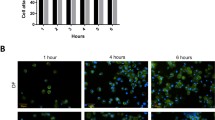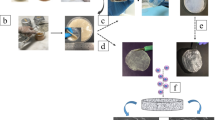Abstract
The healing of wounds, including those from burns, currently exerts a burden on healthcare systems worldwide. Hydrogels are widely used as wound dressings and in the field of tissue engineering. The popularity of bacterial cellulose-based hydrogels has increased owing to their biocompatibility. Previous study demonstrated that bacterial cellulose/acrylic acid (BC/AA) hydrogel increased the healing rate of burn wound. This in vivo study using athymic mice has extended the use of BC/AA hydrogel by the addition of human epidermal keratinocytes and human dermal fibroblasts. The results showed that hydrogel loaded with cells produces the greatest acceleration on burn wound healing, followed by treatment with hydrogel alone, compared with the untreated group. The percentage wound reduction on day 13 in the mice treated with hydrogel loaded with cells (77.34 ± 6.21%) was significantly higher than that in the control-treated mice (64.79 ± 6.84%). Histological analysis, the expression of collagen type I via immunohistochemistry, and transmission electron microscopy indicated a greater deposition of collagen in the mice treated with hydrogel loaded with cells than in the mice administered other treatments. Therefore, the BC/AA hydrogel has promising application as a wound dressing and a cell carrier.




Similar content being viewed by others
References
Sen S, Greenhalgh D, Palmieri T. Review of burn injury research for the year 2009. J Burn Care Res. 2010;31(6):836–48. https://doi.org/10.1097/BCR.0b013e318200ccb6.
Fagenholz PJ, Sheridan RL, Harris NS, Pelletier AJ, Camargo CA. National study of emergency department visits for burn injuries, 1993 to 2004. J Burn Care Res. 2007;28(5):681–90. https://doi.org/10.1097/BCR.0B013E318148C9AC.
Gibran NS, Wiechman S, Meyer W, Edelman L, Fauerbach J, Gibbons L, et al. Summary of the 2012 ABA Burn Quality Consensus Conference. J Burn Care Res. 2013;34(4):361–85. https://doi.org/10.1097/BCR.0b013e31828cb249.
Oryan A, Jalili M, Kamali A. Tissue engineering in burn wound healing: current modalities and future directions. Int Clin Pathol J. 2017;4(1):00085.
Rowan MP, Cancio LC, Elster EA, Burmeister DM, Rose LF, Natesan S, et al. Burn wound healing and treatment: review and advancements. Crit Care. 2015;19(1):243. https://doi.org/10.1186/s13054-015-0961-2.
Kumar RJ, Kimble RM, Boots R, Pegg SP. Treatment of partial-thickness burns: a prospective, randomized trial using Transcyte. ANZ J Surg. 2004;74(8):622–6. https://doi.org/10.1111/j.1445-1433.2004.03106.x.
Wojtowicz AM, Oliveira S, Carlson MW, Zawadzka A, Rousseau CF, Baksh D. The importance of both fibroblasts and keratinocytes in a bilayered living cellular construct used in wound healing. Wound Repair Regen. 2014;22(2):246–55. https://doi.org/10.1111/wrr.12154.
Werner S, Krieg T, Smola H. Keratinocyte-fibroblast interactions in wound healing. J Invest Dermatol. 2007;127(5):998–1008. https://doi.org/10.1038/sj.jid.5700786.
Hassan A, Halim AS, Hilmi ABMA. Bilayer engineered skin substitute for wound repair in an irradiation-impeded healing model on rat. Adv Wound Care (New Rochelle). 2015;4(5):312–20. https://doi.org/10.1089/wound.2014.0551
Hoffman AS. Hydrogels for biomedical applications. Adv Drug Deliv Rev. 2002;54(1):3–12. https://doi.org/10.1016/S0169-409X(01)00239-3
Takei T, Nakahara H, Ijima H, Kawakami K. Synthesis of a chitosan derivative soluble at neutral pH and gellable by freeze thawing, and its application in wound care. Acta Biomater. 2012;8(2):686–93. https://doi.org/10.1016/j.actbio.2011.10.005.
Balakrishnan B, Mohanty M, Umashankar PR, Jayakrishnan A. Evaluation of an in situ forming hydrogel wound dressing based on oxidized alginate and gelatin. Biomaterials. 2005;26(32):6335–42. https://doi.org/10.1016/j.biomaterials.2005.04.012.
Drury JL, Mooney DJ. Hydrogels for tissue engineering: scaffold design variables and applications. Biomaterials. 2003;24(24):4337–51. https://doi.org/10.1016/S0142-9612(03)00340-5.
Sun G, Zhang X, Shen Y, Sebastian R, Dickinson LE, Talbot KF, et al. Dextran hydrogel scaffolds enhance angiogenic responses and promote complete skin regeneration during burn wound healing. Proc Natl Acad Sci. 2011;108(52):20976–81. https://doi.org/10.1073/pnas.1115973108.
Varkey M, Ding J, Tredget EE, Wound-Healing-Research-Group. The effect of keratinocytes on the biomechanical characteristics and pore microstructure of tissue engineered skin using deep dermal fibroblasts. Biomaterials. 2014;35(36):9591–8. https://doi.org/10.1016/j.biomaterials.2014.07.048.
Cacicedo ML, Castro MC, Servetas I, Bosnea L, Boura K, Tsafrakidou P, et al. Progress in bacterial cellulose matrices for biotechnological applications. Bioresour Technol. 2016;213:172–80. https://doi.org/10.1016/j.biortech.2016.02.071.
Fu L, Zhang J, Yang G. Present status and applications of bacterial cellulose-based materials for skin tissue repair. Carbohydr Polym. 2013;92(2):1432–42. https://doi.org/10.1016/j.carbpol.2012.10.071.
Wippermann J, Schumann D, Klemm D, Kosmehl H, Salehi-Gelani S, Wahlers T. Preliminary results of small arterial substitute performed with a new cylindrical biomaterial composed of bacterial cellulose. Eur J Vasc Endovasc. 2009;37(5):592–6. https://doi.org/10.1016/j.ejvs.2009.01.007.
Czaja W, Krystynowicz A, Bielecki S, Brown RM. Microbial cellulose—the natural power to heal wounds. Biomaterials. 2006;27(2):145–51. https://doi.org/10.1016/j.biomaterials.2005.07.035.
Kwak MH, Kim JE, Go J, Koh EK, Song SH, Son HJ, et al. Bacterial cellulose membrane produced by Acetobacter sp. A10 for burn wound dressing applications. Carbohydr Polym. 2015;122:387–98. https://doi.org/10.1016/j.carbpol.2014.10.049
Muangman P, Opasanon S, Suwanchot S, Thangthed O. Efficiency of microbial cellulose dressing in partial-thickness burn wounds. J Am Coll Certif Wound Spec. 2011;3(1):16–9. https://doi.org/10.1016/j.jcws.2011.04.001
Klemm D, Schumann D, Udhardt U, Marsch S. Bacterial synthesized cellulose—artificial blood vessels for microsurgery. Prog Polym Sci. 2001;26(9):1561–603. https://doi.org/10.1016/S0079-6700(01)00021-1.
Mohamad N, Mohd Amin MC, Pandey M, Ahmad N, Rajab NF. Bacterial cellulose/acrylic acid hydrogel synthesized via electron beam irradiation: accelerated burn wound healing in an animal model. Carbohydr Polym. 2014;114:312–20. https://doi.org/10.1016/j.carbpol.2014.08.025.
Mohamad N, Buang F, Mat Lazim A, Ahmad N, Martin C, Mohd Amin MC. Characterization and biocompatibility evaluation of bacterial cellulose-based wound dressing hydrogel: effect of electron beam irradiation doses and concentration of acrylic acid. J Biomed Mater Res B Appl Biomater. 2017;105(8):2553–64. https://doi.org/10.1002/jbm.b.33776.
Seet WT, Manira M, Khairul Anuar K, Chua KH, Ahmad Irfan AW, Ng MH, et al. Shelf-life evaluation of bilayered human skin equivalent, MyDerm™. PLoS One. 2012;7:e40978. https://doi.org/10.1371/journal.pone.0040978
Loo Y, Wong YC, Cai EZ, Ang CH, Raju A, Lakshmanan A, et al. Ultrashort peptide nanofibrous hydrogels for the acceleration of healing of burn wounds. Biomaterials. 2014;35:1–10. https://doi.org/10.1016/j.biomaterials.2014.02.047
Busra MF, Chowdhury SR, Ismail F, Saim A, Idrus RH. Tissue-engineered skin substitute enhances wound healing after radiation therapy. Adv Skin Wound Care. 2016;29(3):120–9. https://doi.org/10.1097/01.ASW.0000480556.78111.e4.
Idrus RB, Rameli MA, Low KC, Law JX, Chua KH, Latiff MB, et al. Full-thickness skin wound healing using autologous keratinocytes and dermal fibroblasts with fibrin: bilayered versus single-layered substitute. Adv Skin Wound Care. 2014;27(4):171–80. https://doi.org/10.1097/01.ASW.0000445199.26874.9d.
Rogers AA, Walmsley RS, Rippon MG, Bowler PG. Adsorption of serum-derived proteins by primary dressings: implications for dressing adhesion to wounds. J Wound Care. 2016;8:403–6. https://doi.org/10.12968/jowc.1999.8.8.25910
Qiu Y, Qiu L, Cui J, Wei Q. Bacterial cellulose and bacterial cellulose-vaccarin membranes for wound healing. Mater Sci Eng C Mater Biol Appl. 2016;59:303–9. https://doi.org/10.1016/j.msec.2015.10.016.
Li J, Chen J, Kirsner R. Pathophysiology of acute wound healing. Clin Dermatol. 2007;25(1):9–18. https://doi.org/10.1016/j.clindermatol.2006.09.007.
Arai M, Matsuzaki T, Ihara S. Wound closure on the neonatal rat skin I. The modulation of the thickness of epidermis at the closing incisional wounds. CellBio. 2013;2(4):248–56. https://doi.org/10.4236/cellbio.2013.24027.
Boateng JS, Matthews KH, Stevens HN, Eccleston GM. Wound healing dressings and drug delivery systems: a review. J Pharm Sci. 2008;97(8):2892–923. https://doi.org/10.1002/jps.21210.
Lorenti A. Wound healing: from epidermis culture to tissue engineering. CellBio. 2012;1(02):17–29. https://doi.org/10.4236/cellbio.2012.12003.
Madaghiele M, Demitri C, Sannino A, Ambrosio L. Polymeric hydrogels for burn wound care: advanced skin wound dressings and regenerative templates. Burns Trauma. 2014;2(4):153–61. https://doi.org/10.4103/2321-3868.143616.
Candi E, Schmidt R, Melino G. The cornified envelope: a model of cell death in the skin. Nat Rev Mol Cell Biol. 2005;6(4):328–40. https://doi.org/10.1038/nrm1619.
Smiley AK, Klingenberg JM, Boyce ST, Supp DM. Keratin expression in cultured skin substitutes suggests that the hyperproliferative phenotype observed in vitro is normalized after grafting. Burns. 2006;32(2):135–8. https://doi.org/10.1016/j.burns.2005.08.017.
Byrne C, Tainsky M, Fuchs E. Programming gene expression in developing epidermis. Development. 1994;120(9):2369–83.
Kumar V, Cotran RZ, Robbins SL. Basic pathology. 7th ed. Philadelphia: Saunders; 2003. p. 873.
Gurtner GC, Werner S, Barrandon Y, Longaker MT. Wound repair and regeneration. Nature. 2008;453(7193):314–21. https://doi.org/10.1038/nature07039.
Darby I, Skalli O, Gabbiani G. Alpha-smooth muscle actin is transiently expressed by myofibroblasts during experimental wound healing. Lab Investig. 1990;63(1):21–9.
Desmouliere A, Guyot C, Gabbiani G. The stroma reaction myofibroblast: a key player in the control of tumor cell behavior. Int J Dev Biol. 2004;48(5–6):509–17. https://doi.org/10.1387/ijdb.041802ad.
Serini G, Gabbiani G. Mechanisms of myofibroblast activity and phenotypic modulation. Exp Cell Res. 1999;250(2):273–83. https://doi.org/10.1006/excr.1999.4543.
Darby IA, Laverdet B, Bonte F, Desmouliere A. Fibroblasts and myofibroblasts in wound healing. Clin Cosmet Investig Dermatol. 2014;7:301–11. https://doi.org/10.2147/CCID.S50046.
Desmouliere A, Redard M, Darby I, Gabbiani G. Apoptosis mediates the decrease in cellularity during the transition between granulation tissue and scar. Am J Pathol. 1995;146(1):56–66.
Brandner JM, Haftek M, Niessen CM. Adherens junctions, desmosomes and tight junctions in epidermal barrier function. Open Dermatol J. 2010;4:14–20.
Funding
This work was supported by funding from Universiti Kebangsaan Malaysia (GP-K007818 and DIP-2015-026).
Author information
Authors and Affiliations
Corresponding author
Ethics declarations
Conflict of interest
The authors declare that they have no conflict of interest.
Ethics approval and consent to participate
All procedures followed were in accordance with the ethical standards of the responsible committee on human experimentation (institutional and national) and with the Helsinki Declaration of 1975, as revised in 2000 (5). Informed consent was obtained from all patients for being included in the study.
All institutional and national guidelines for the care and use of laboratory animals were followed.
Rights and permissions
About this article
Cite this article
Mohamad, N., Loh, E.Y.X., Fauzi, M.B. et al. In vivo evaluation of bacterial cellulose/acrylic acid wound dressing hydrogel containing keratinocytes and fibroblasts for burn wounds. Drug Deliv. and Transl. Res. 9, 444–452 (2019). https://doi.org/10.1007/s13346-017-0475-3
Published:
Issue Date:
DOI: https://doi.org/10.1007/s13346-017-0475-3




